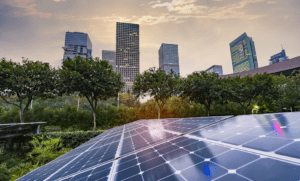The Regenerative Data Center—a groundbreaking new concept I couldn’t have imagined a decade ago. It will generate its own renewable power on-site, replace all the water it consumes and recycle all the materials and hardware it uses in its core and shell, IT, power and cooling systems. Yes—the Regenerative Data Center is entirely self-supporting!
Why do we need regenerative data centers?
Data centers come under fire because they consume a considerable amount of electricity and water, emit carbon, and generate waste in landfills without producing tangible products—like cars, houses and steel. But data centers do produce useful outputs that an automated world depends on, like music and video streaming, ridesharing, online shopping, process and manufacturing control, banking and brokerage, immersive video meetings and more.
Our digitized world requires a proportional amount of processing and storage, causing exponential demand for data centers to the point where they will account for 2% of global electricity demand within the next few years. While I and many others have been working on strategies and solutions to make data centers more efficient and sustainable, it may not be enough.
Going forward, I contend that data centers must be regenerative.

Renewable power must be generated on-site.
To regeneratively power a data center, the first step is that the renewables needed to run and back up the entire data center must be generated on-site. It’s not enough for the data center operator to buy power purchase agreements, energy credits or even source off-site renewable grid power from the utility. A data center with a running river and a hydro plant on-site qualifies, as do solar and wind power. However, the data center must also operate in times of drought, zero wind and darkness, so many forms of on-site renewable power are needed or significant amounts of on-site energy storage.
Battery storage is becoming more attractive from a price-performance perspective. If there is excess renewable capacity from wind, solar or hydro, this energy can be stored in batteries or made into green hydrogen. An electrolyzer plant would be needed on-site, along with a means to store and compress the hydrogen. Additionally, a fuel cell would be the best bet to turn this stored green hydrogen into electricity. Alternatively, if a farm is on-site, generators that operate on bio-fuels can also be part of the system.
Small, modular nuclear reactors (SMRs) that can be built in factories and shipped to a site have started obtaining regulatory design approvals but need to go through rigorous testing. They seem to be a fit to power Regenerative Data Centers, but the first generation of these will not be built until after 2030.
Heat needs to be used and water generated.
Data centers typically use water for cooling as they generate quite a bit of heat. The industry is experimenting with funneling this heat to useful applications. Heating buildings for occupants is one way. Another is to use industrial manufacturing applications as the heat source—petrochemicals, cement, wood pellets, etc.
A use that makes sense and is beneficial for a Regenerative Data Center is water desalination plants. These plants require energy to power pumps and heat to drive evaporation by converting ocean water or seawater into fresh water. Ideally, a Regenerative Data Center would be located in an area with a plentiful seawater supply with on-site renewable power generation and heat provided by the data center operations. In addition to desalination plants, systems that can capture and store rainwater could be key to water regeneration, but careful, thoughtful study is essential to not upset ecosystems.
Circularity is a must.
Data center hardware and building materials must be 100% recyclable. Large data centers use steel, cement, lumber, aluminum, rubber and copper, to name a few, in their core and shell and power systems. Add to that plastics, gold, lithium and lead from the IT systems and battery backup. Regenerative Data Centers need to be designed using digital design software and digital construction software utilizing BIM and digital twins. Modeling the designs with these tools will provide a recyclability factor. Designs and components can then be swapped out to maximize the recyclability of the core and shell and the IT systems.
In the future, the entire data center should be recyclable, and, of course, it must be to qualify as regenerative.
The Ultimate Goal.
Data center sustainability initiatives are an important starting point in the race to regenerative, but they are not enough. The ultimate goal should not be to control carbon outputs and minimize water use and waste. The ultimate goal is a self-sustaining data center defined by renewable power generation on-site, water neutrality, and 100% circular materials eliminating all landfill waste—this is the Regenerative Data Center.
This article was previously published in Forbes.



